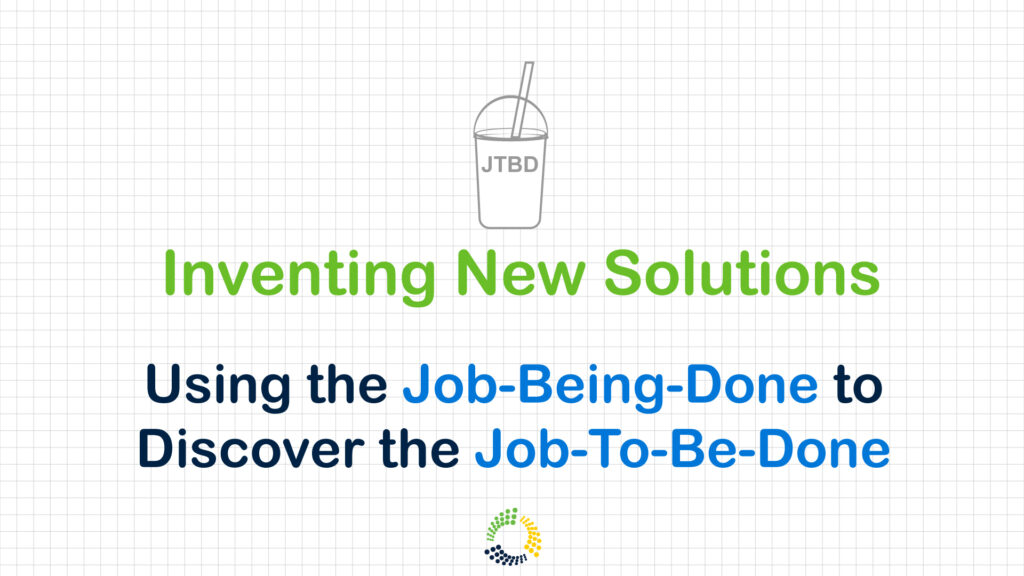
This edition of the Agile Innovating TMNewsletter is for Innovators who want to improve their ability to generate high impact solutions.
In previous editions of the Newsletter, we have written about how looking for trouble in the user experience can help you identify problems worth solving. We have also written about what a good innovative idea looks like. Today’s edition closes the gap between “trouble as the source” and “good solutions” to write about where good ideas come from.
The Jobs-To-Be-Done (JTBD) framework is a foundational methodology for identifying the situational context where specific solutions are desired and utilized. JTBD recognizes the user experience with available solutions as the fertile ground from which new solutions grow.
People are doers. In every facet of life, people are doing things to get specific results and achieve certain outcomes. In every case, people acquire and employ solutions to get a parrticular job done. These solutions, which could be a product, a service, a process, or some combination of all three, are characterized by a user experience specific to the situation and solution.
There is an available solution for every job a person wants to do. But no solution is ever perfect. Every solution has some kind of trouble associated with using it. Because of this fact, the user experience of utilizing their solution of choice can be improved in some way.
The results derived and outcomes achieved by utilizing the solution of choice defines the Job-Being-Done. Improving the user experience and reducing the net trouble associated with the current solution is the Job-To-Be-Done.
Specifying the Characteristics of a Job
Every job a person seeks to do can be specified in a common framework.
· Who – the person who is using a solution and anticipating deriving the benefit when the job is completed.
· What – the job the user wants done.
· Why – the desired results and outcomes of completing the job.
· Where – the location where the solution will be utilized.
· When – the time and duration of doing the job.
· How – the solution of choice to perform the job.
· How Often – the frequency the job will be done.
· How Much – the quantity or amount of the solution utilized to complete the job.
The job characteristics define the situational context where a solution makes sense.
Quantifying the User Experience with the Job-Being-Done
The user experience with every solution is a cognitive and emotional reaction to how well a job is being done. User satisfaction / frustration with a solution is a fusion of distinctive attributes in the areas of:
· Constraints encountered
Constraints encountered include time, performance limitations, availability, accessibility, price, and solution complexity.
· Performance delivered
Performance delivered includes conformance to specification for the primary function and secondary features, and ease of use.
· Utility derived
Utility derived includes reliability, durability, and serviceability.
· Outcomes achieved
Outcomes achieved includes; saving time, money or effort; providing novelty, assurance, or protection; yielding a psychological reward by making you feel special, appreciated, or connected.
Dissatisfaction with the user experience associated with getting a job done is the trigger that makes a new solution possible. The probability of a new solution replacing an existing solution is dependent upon the frequency and intensity of the feelings of dissatisfaction, and the awareness that a new solution can decease those feelings.
Using Trouble as the Indicator to Define the New Job-To-Be-Done
Trouble can be an ambiguous concept. In it’s simplest description, trouble is the source of the cognitive and emotional reaction of “This solution isn’t working for me, and I don’t like it!”. The more trouble you experience with a solution, the more dissatisfaction you feel.
Trouble comes in many forms. Trouble is some combination of:
· A breakdown or failure
· Too much variance or uncertainty in performance, utility, or outcomes
· A constraint
· Unrealized expected benefits
· Unresolved challenges
· Anomalous behavior (something unusual, unexpected, abnormal, or peculiar)
· An unsatisfying event or paradox (something difficult to do or understand)
Looking for trouble within the boundaries of the Job-Being-Done by the solution of choice exposes the limitations, compromises, and difficulties a user must deal with to get the job done. Any change you conceive of making to the characteristics of the job or in the user experience because of the trouble encountered becomes the specification for the new Job-To-Be-Done.
Conclusion
The new Job-To-Be-Done can be focused on improving the solution of choice for the existing job, or it can involve inventing a new solution for a different job.
Improving an available solution for an existing job typically involves the process improvement skills associated with Incremental Innovation, or the product improvement skills associated with Sustaining Innovation.
Defining a different job, along with the invention of a novel solution, requires the individual and organizational product, service, and process skills associated with Radical Innovation.
Regardless of whether you decide to target Incremental, Sustaining, or Radical innovation, the Job-To-Be-Done framework provides a disciplined approach that makes innovation the norm.
🌱
People need jobs done
Old solutions can frustrate
Seek new solutions
-Innovation Haiku, Kevin A Fee, March 6, 2024
